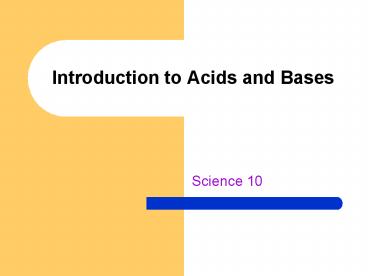Introduction to Acids and Bases - PowerPoint PPT Presentation
1 / 14
Title:
Introduction to Acids and Bases
Description:
Do your muscles ever feel sore after a heavy workout? ... Think of the taste of fruits such as lemons or limes. These fruits contain citric acid. ... – PowerPoint PPT presentation
Number of Views:45
Avg rating:3.0/5.0
Title: Introduction to Acids and Bases
1
Introduction to Acids and Bases
- Science 10
2
Introduction to Acids
- Do your muscles ever feel sore after a heavy
workout? - If so, you can blame a buildup of lactic acid in
your muscles. - Lactic acid is a by-product of cell metabolism
when too little oxygen is available.
Sore muscles and sour milk are caused by the same
acid.
3
Introduction to Acids (cont)
- Lactic acid is also produced by bacteria in milk
this is why milk turns sour. - Acids occur naturally in many fruits.
- Insects such as millipedes, scorpions, and ants
use acids to deter predators. - A physician may use a solution of boric acid to
rinse out your eyes, but a drop or two of many
other acids would blind you. - Some acids add a tangy, sour flavour to foods and
drinks, while others are deadly.
4
Introduction to Bases
- Bases are bitter-tasting compounds with a
slippery feel. - Most soaps and drain and window cleaners are
bases.
5
Introduction to Bases (cont)
- Quinine is a base which is responsible for the
bitter flavour of tonic water and it occurs
naturally in the bark of the cinchona tree. - Quinine is also used as a drug to treat malaria.
- Many other drugs are bases, too.
- For example, lidocaine, a local anaestheic used
by dentists, is a base. - Like acids, some bases are harmless while others
are very dangerous.
6
Word Connect
- The word acid comes from the Latin acidus,
meaning sour. Think of the taste of fruits such
as lemons or limes. These fruits contain citric
acid. Vinegar, a common household product,
contains acetic acid. - Chemists sometimes use the term alkali for a
base that is soluble in water. This word shows
the Arabic origin of chemistry. The earliest
source of bases was the ash obtained by burning
plants. Thus the Arabic word alkali means ashes
of a plant. What clue does the word alkali
give you about the kinds of elements that you
might find in a basic compound?
7
Defining Acids
- Most acids and bases dissolve in water.
- In 1884 the Swedish chemist Svante Arrhenius
defined an acid as a substance that produces
hydrogen ions in solution, H (aq). - For example, HCl (aq), hydrochloric acid is an
ionic compound that dissolves in water, splitting
into H (aq) and Cl (aq) ions. - The resulting solution is an electrolyte.
8
Defining Bases
- Arrhenius also defined a base as a substance that
produces hydroxide ions in solution, OH (aq). - An example of a base is sodium hydroxide, NaOH
(aq). Sodium hydroxide forms OH ions in
solution.
Svante Arrhenius (1859-1927)
9
Defining Indicators
- Most solutions of acids or bases are clear and
colourless. Therefore they cannot be
distinguished from ordinary water by appearance
alone. - The simplest way to distinguish them from water
is to use an indicator. - An indicator is a chemical that changes colour as
the concentration of H (aq) or OH (aq) changes.
10
Defining Indicators (cont)
- Two of the most common indicators are
phenolphthalein and litmus. - Litmus is a compound that is extracted from
lichens, a plant-like member of the fungi
kingdom. Litmus paper is made by dipping paper in
litmus solution.
11
The Oxides of Elements
- Oxides of many elements react with water to form
an acid or a base. - An oxide is a compound that consists of an
element combined with only oxygen. For example,
CO (carbon monoxide), CO2 (carbon dioxide), and
Al2O3 (aluminum oxide) are oxides. H2SO4 and HNO3
are not.
12
13
Check Your Understanding
- In your own words, summarize Arrhenius theory
about acids and bases. - Balance each of the following skeleton ion
equations. Identify the substance on the left of
the equation as an acid or a base. - H2CO3 (aq) ? H (aq) CO3 2- (aq)
- Ca(OH)2 (aq) ? Ca 2 (aq) OH- (aq)
- KOH (aq) ? K (aq) SO4 2- (aq)
14
Check Your Understanding (cont)
- 3. Chris observes that a drop of an unknown
solution on red litmus paper causes no colour
change. Chris correctly concludes the solution is
either neutral or acidic, but cannot be sure
which. Explain. What further test(s) could Chris
perform to identify whether the solution is, in
fact, neutral or acidic?































